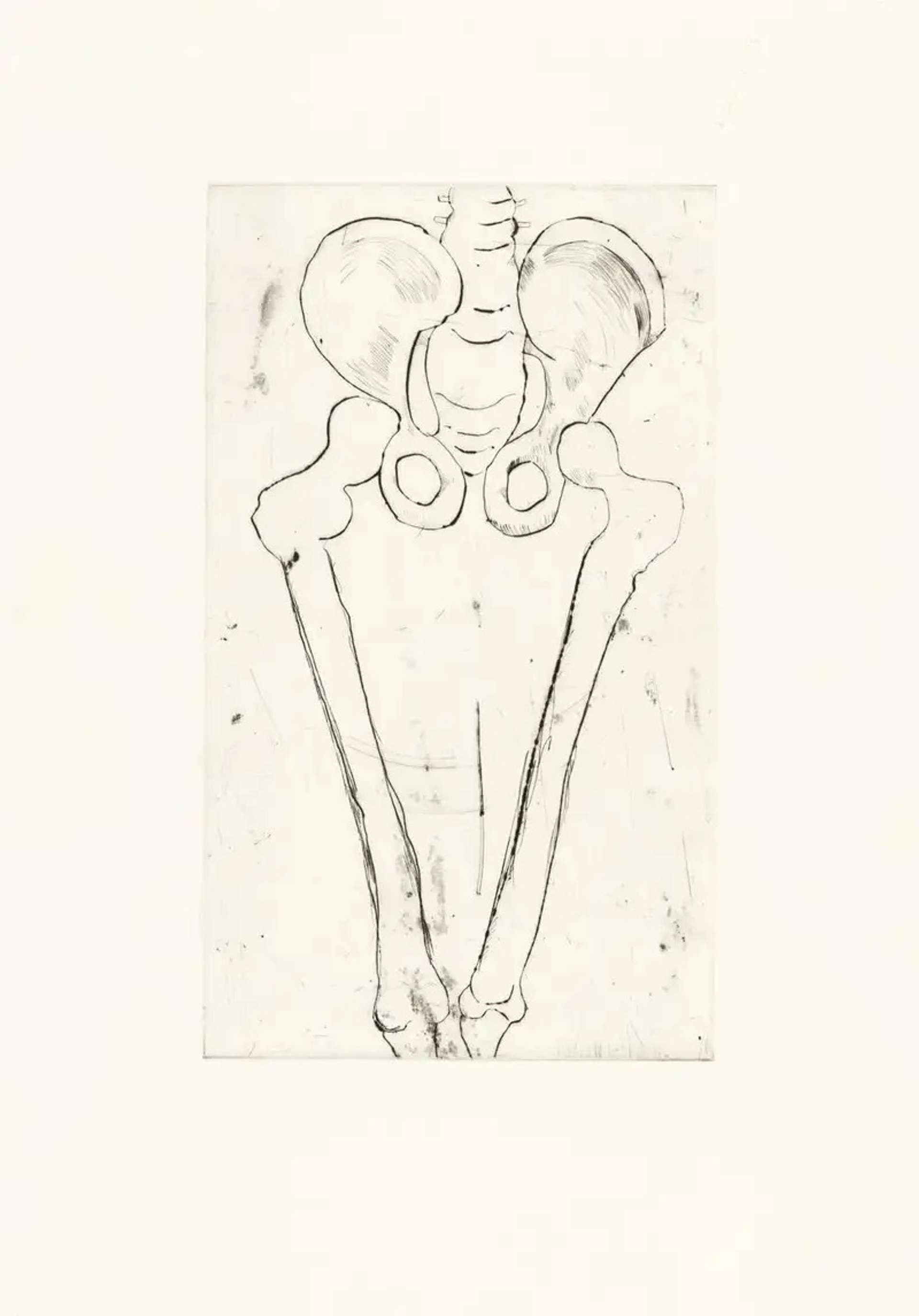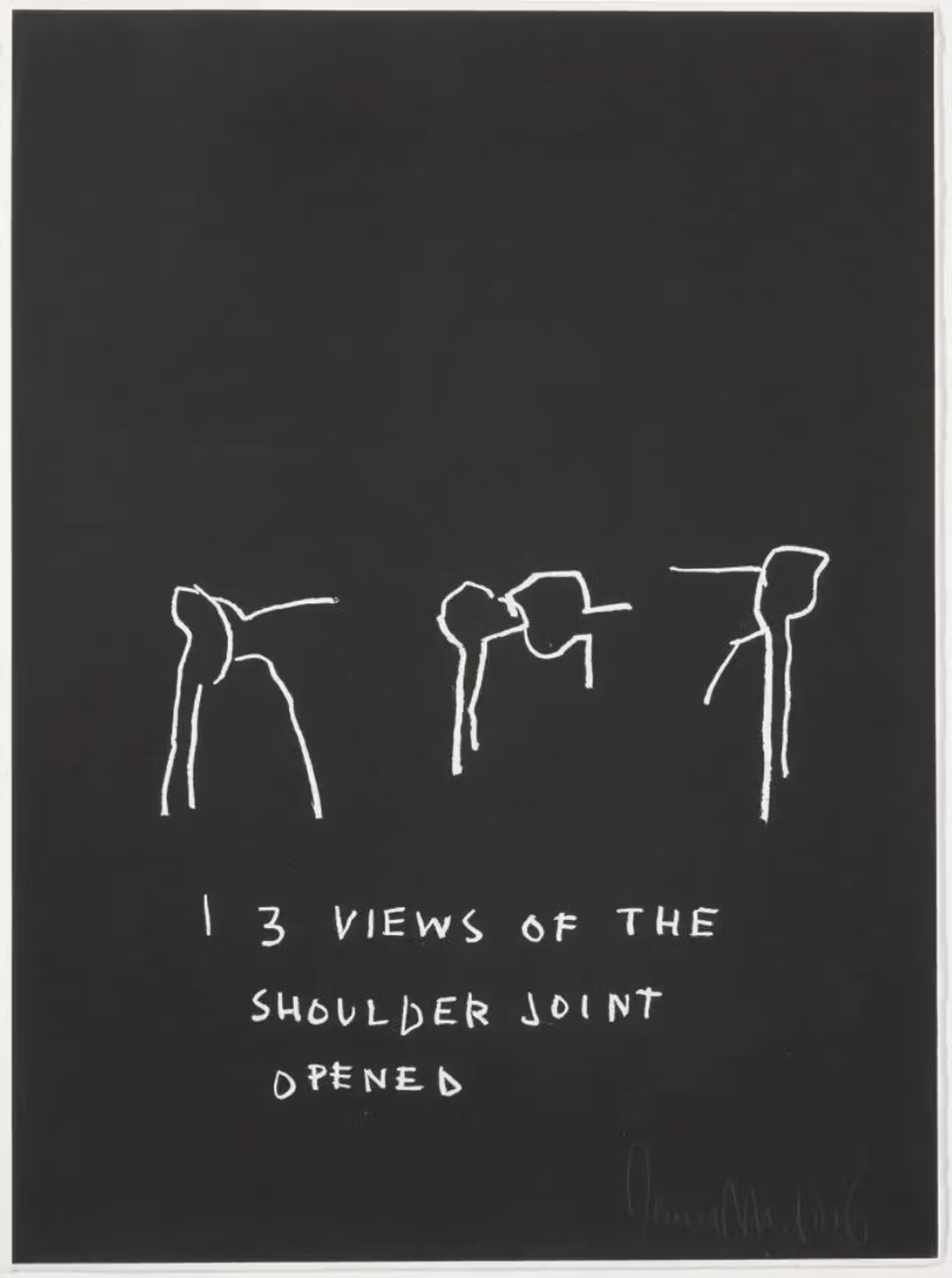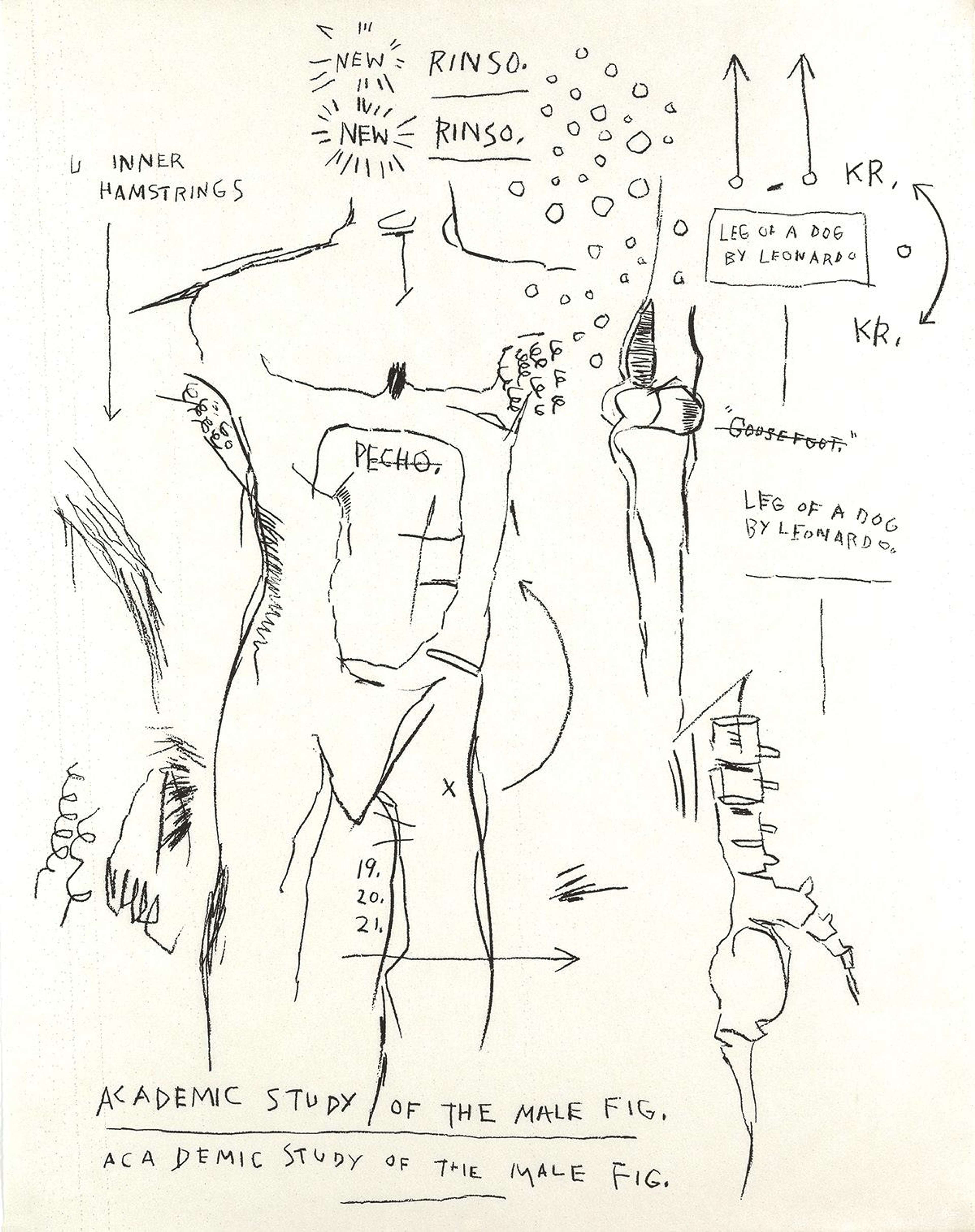Louise Bourgeois and Jean-Michel Basquiat: Anatomical Works

 Anatomy (complete set) © Jean-Michel Basquiat 1982
Anatomy (complete set) © Jean-Michel Basquiat 1982
Louise Bourgeois
104 works
Louise Bourgeois and Jean-Michel Basquiat, each in their unique way, revolutionised the portrayal of the human body in modern art, exploring its complexities with depth and emotion. Through their respective anatomical series, they laid bare the layers of human vulnerability, identity and existence – a testament to the power of anatomical art to express the most profound aspects of the human experience. Engaging with themes of trauma, healing and resilience, Bourgeois and Basquiat invite us into a dialogue with our own physical and psychological landscapes, challenging us to confront the beauty and brutality of what it means to be human.
Louise Bourgeois: Emotion Through Form
Bourgeois was an influential French-American artist known for her extensive contributions to modern and contemporary art, particularly through her sculpture, installations, and drawings. Born on December 25, 1911, in Paris, she grew up in a family that ran a tapestry restoration workshop, a background that deeply influenced her later textile works. Bourgeois studied art in Paris, attending various schools including the École du Louvre and the École des Beaux-Arts, before moving to New York in 1938 after marrying American art historian Robert Goldwater.
Bourgeois's work is renowned for its intense emotional depth and its exploration of themes such as family, sexuality and death, often drawing on her own life experiences for inspiration. She achieved fame for her large-scale sculptures and installations that often incorporated anatomical forms and motifs of spiders, which she used as symbols for protection. One of her most famous works, Maman, is a giant spider sculpture that stands as a tribute to her mother – embodying strength, nurture, and repair. Bourgeois's art was not limited to any single medium, as she also worked with a variety of materials including wood, metal, stone, and fabric, demonstrating her versatility and innovative approach to art.
Despite her significant contributions, Bourgeois did not receive widespread recognition until later in her career, becoming a prominent figure in the art world in the 1970s and 1980s. Her work has been exhibited in major museums and galleries around the world, and she continued to create and exhibit new works well into her 90s. Bourgeois passed away on May 31, 2010, but her legacy endures through her influential body of work, which continues to challenge audiences through her exploration of complex psychological themes and her pioneering use of materials and form.
Bourgeois' Anatomy Series
Bourgeois created her Anatomy series in 1990, when she was well into her career. It is a profound exploration of the human form, marrying the intricacies of bodily structures with the vast landscapes of emotion and psyche through the medium of etching. This series emerged organically from Bourgeois' spontaneous and intuitive creative process, reflecting a deep and intuitive engagement with the themes of identity, vulnerability, and the complex layers of human experience. The collaboration with SOLO Impression was pivotal, bringing technical mastery and artistic vision together to produce a body of work that demonstrates a remarkable use of the drypoint technique. This method, celebrated for its ability to render velvety lines, enabled Bourgeois to delve into the physicality and symbolism of human anatomy with extraordinary depth and sensitivity.
In works such as Untitled No. 2 and Untitled No. 4, Bourgeois employs powerful visual metaphors to explore themes of introspection, societal judgement, femininity, and vulnerability. Untitled No. 2 uses obscured eyes as a symbol for the fear of being seen, a poignant commentary on self-awareness and the human condition, while Untitled No. 3 employs the motif of a helix to navigate the complexities of relationships, signifying the balance between union and autonomy even within our own DNA. Bourgeois' artistry bridges the tangible form with the psychological realm, offering viewers a reflective experience that challenges them to confront their own identities and vulnerabilities.
Each etching becomes a dialogue between Bourgeois' explorations of the human condition and the viewer's personal reflections on intimacy, isolation and the inevitable search for connection. Through this series, Bourgeois reveals the intimate connections between our physical forms and inner selves, inviting a contemplative engagement with the universal experiences of human life.
Jean-Michel Basquiat: Street Art's Radiant Child
Basquiat was a visionary artist whose meteoric rise in the 1980s New York scene set the footprint for the treatment of prodigious talent in contemporary art. Born in Brooklyn in 1960 to a Haitian father and a Puerto Rican mother, his early exposure to a multicultural environment and frequent visits to art museums fuelled his passion for art from a young age. Basquiat's career began in the late 1970s under the graffiti tag "SAMO," a collaborative project with friend Al Diaz that critiqued the superficiality of New York's art world and society. This period of experimentation with street art laid the groundwork for his explosive entry into the gallery scene.
Basquiat's work is characterised by its raw energy, bold colour palettes and use of fragmented figures combined with text, symbols. He utilises a plethora of references ranging from his personal heritage to political issues, anatomy and history. His unique style was influenced by a variety of sources, including African art, jazz, sports, and his own Caribbean heritage, which he integrated into a distinct visual language that was both deeply personal and universally resonant. Basquiat’s art was a fusion of poetry, drawing and painting, often featuring a blend of words and imagery that confronted issues of racism, power and social hypocrisy. The intensity of his work was matched by his prolific output: he produced a vast body of work within his short career, including paintings, drawings and notebooks.
Despite his success, Basquiat's life was marked by challenges, including a struggle with drug addiction and the pressures of fame. His untimely death in 1988 at the age of 27 did not diminish the impact of his work but rather intensified it. Basquiat's legacy has continued to grow, with his art gaining in value and prominence, often being a favourite of celebrities. Today, he is celebrated as a pioneering figure of the Neo-Expressionist movement, a critical voice in discussions of race and identity in art, and a symbol of the vibrant, tumultuous energy of 1980s New York. Basquiat's work remains a powerful testament to his genius, offering a poignant commentary on the complexities of the human condition and the injustices of society.
Basquiat's Anatomy Series
Basquiat’s Anatomy series, composed of 18 works, presents a notable shift in his artistic exploration, moving from the vibrant chaos and socio-political commentary characteristic of his broader oeuvre to a concentrated introspection on the human form. This collection is marked by a monochromatic palette, a stark departure from the explosive colours Basquiat typically employed, which serves to intensify the focus on the anatomical structures he depicts. The influence of personal experiences – notably a childhood accident that led to his prolonged interaction with the anatomical book Gray's Anatomy and the possession of Leonardo Da Vinci's manuscripts – imbues the series with a depth that transcends mere observation. The use of drawing as the sole medium in the Anatomy series underscores Basquiat's commitment to the foundational aspects of art, emphasising the potency of line and form to convey complex narratives. This back-to-basics approach, coupled with the literal use of text to provide context to the imagery, showcases Basquiat's ability to strip down his typically layered and symbol-laden work to something more immediate and accessible, yet no less profound.
Within the Anatomy series, Basquiat navigates the delicate balance between clinical detachment and intimate exploration. His works, while rooted in the personal, branch out to engage with themes of identity, existence, and the fragility of the human body. The inclusion of text in a straightforward manner, diverging from his often cryptic and layered use of words, acts as a guide and leads the viewer through a more direct engagement with the technicalities of the work. This series, though it may appear as a departure at first, is deeply entrenched in Basquiat's ongoing dialogue with the human experience, offering a moment of reflection on the marvels of the human body beyond its socio-political significations. This series offers a unique perspective on Basquiat's artistic journey, highlighting his versatility and depth as an artist capable of challenging the viewer to reconsider the human body in its most elemental form. Through Anatomy, Basquiat invites us to see the body not as a mere biological entity, but as a profound emblem of human identity.
From Emotional Depth to Structural Beauty: Navigating Anatomy with Bourgeois and Basquiat
Both Anatomy series are defined by their minimalist form and monochromatic palette. This elevates the emotional intensity of each piece, focusing the viewer's attention on the raw forms and underlying themes presented by each artist – this choice underscores their ability to communicate complex emotional states through simple contrasts, using the human form not just as a subject of artistic representation but as a narrative tool, exploring the intersection between the personal and the universal. Nevertheless, each artist approaches the subject with their own lens.
Bourgeois delves into the intimate and intricate relationship between physical form and emotional depth. Her use of drypoint etching allows for a tactile, sensitive portrayal of human anatomy, particularly female anatomy, intertwining it with the layers of the human psyche. The personal and introspective nature of her work invites viewers into a reflective dialogue with the intricacies of their own existence, making each piece a deeply engaging exploration of the self. In contrast, Basquiat’s Anatomy is marked by a deliberate shift to a monochromatic palette and a focus on drawing, which strips his vibrant, narrative-rich canvases down to their essence. While Bourgeois’ pieces are dense with emotional and psychological exploration, Basquiat presents the human form in a more detached manner, yet not without its own depth and contemplation. His work leans towards an objective celebration of the body’s architecture, influenced by personal history and a fascination with Da Vinci’s anatomical sketches.
Despite the difference in approach, both artists use the anatomy as a tool to transcend the purely physical; Bourgeois channels it to navigate the emotional and psychological terrains of human experience, while Basquiat uses it to ponder on broader themes of existence and identity, free from the confines of societal constructs.
Thus, while Bourgeois' and Basquiat's Anatomy series share a thematic focus, they diverge significantly in their execution and underlying intent. Nevertheless, through their respective series, both artists enrich the discourse on the portrayal of the human body in art.










